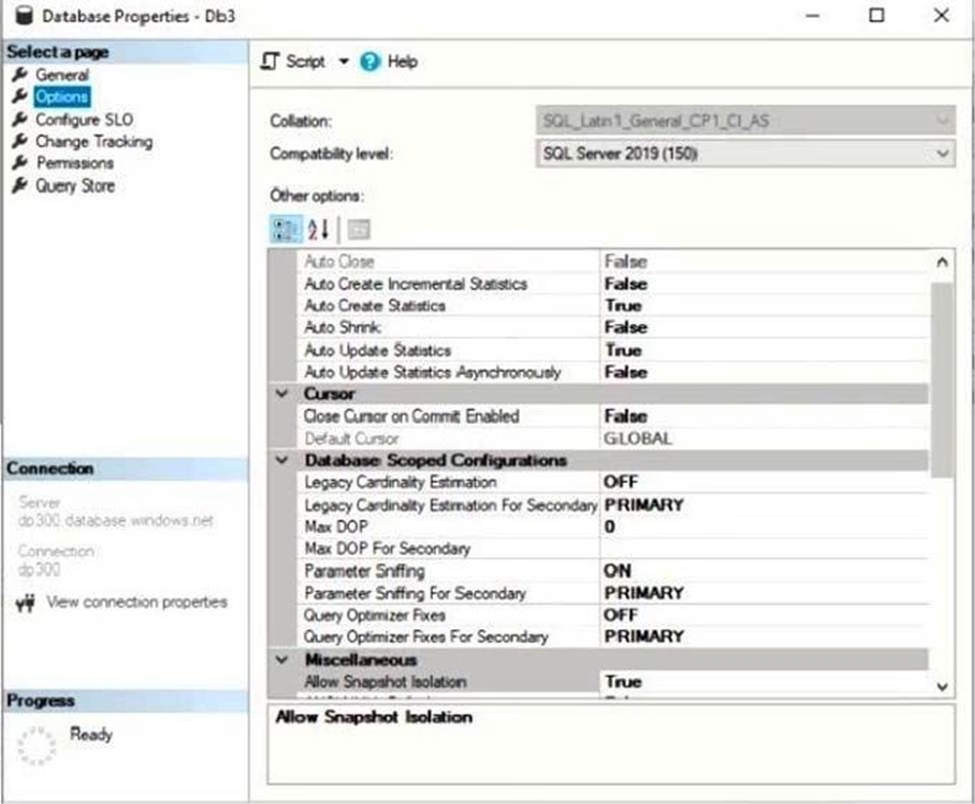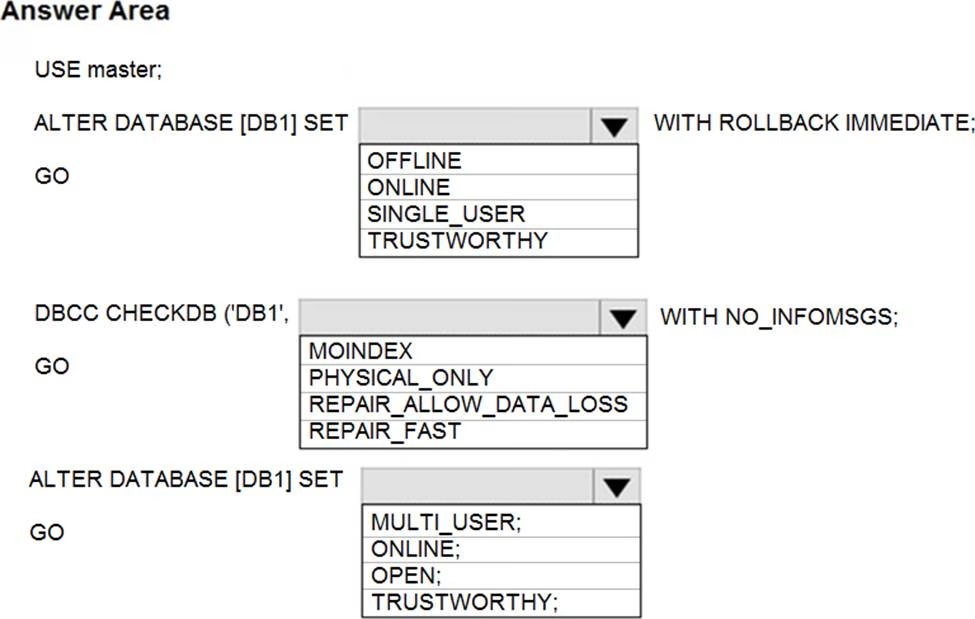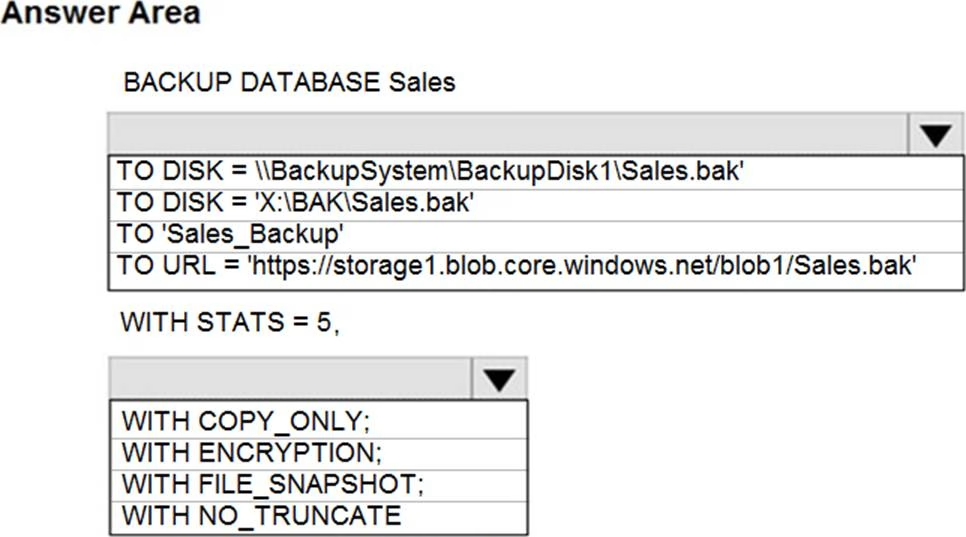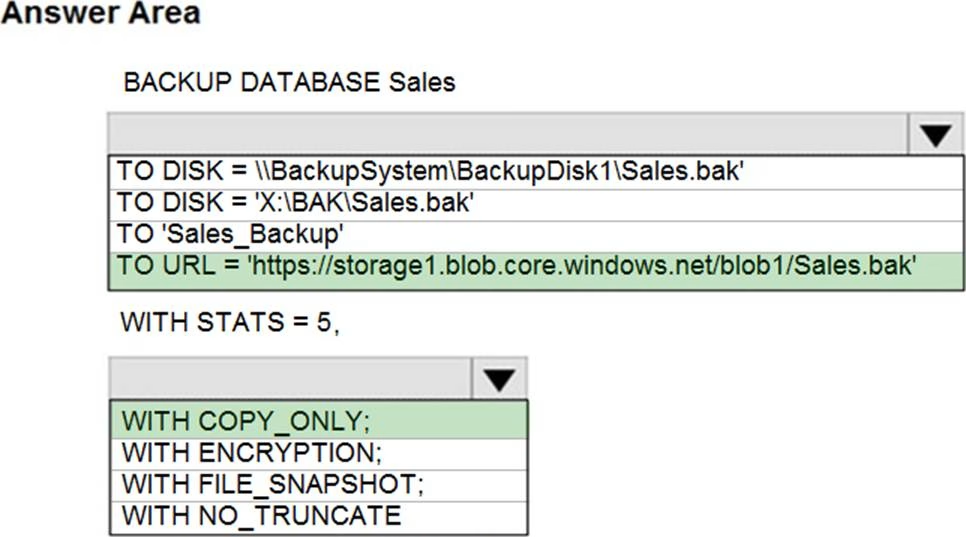Microsoft DP-300 Administering Microsoft Azure SQL Solutions Online Training
Microsoft DP-300 Online Training
The questions for DP-300 were last updated at Nov 08,2025.
- Exam Code: DP-300
- Exam Name: Administering Microsoft Azure SQL Solutions
- Certification Provider: Microsoft
- Latest update: Nov 08,2025
You have SQL Server on Azure virtual machines in an availability group.
You have a database named DB1 that is NOT in the availability group.
You create a full database backup of DB1.
You need to add DB1 to the availability group.
Which restore option should you use on the secondary replica?
- A . Restore with Recovery
- B . Restore with Norecovery
- C . Restore with Standby
You have SQL Server on Azure virtual machines in an availability group.
You have a database named DB1 that is NOT in the availability group.
You create a full database backup of DB1.
You need to add DB1 to the availability group.
Which restore option should you use on the secondary replica?
- A . Restore with Recovery
- B . Restore with Norecovery
- C . Restore with Standby
You have SQL Server on Azure virtual machines in an availability group.
You have a database named DB1 that is NOT in the availability group.
You create a full database backup of DB1.
You need to add DB1 to the availability group.
Which restore option should you use on the secondary replica?
- A . Restore with Recovery
- B . Restore with Norecovery
- C . Restore with Standby
You are planning disaster recovery for the failover group of an Azure SQL Database managed instance.
Your company’s SLA requires that the database in the failover group become available as quickly as possible if a major outage occurs.
You set the Read/Write failover policy to Automatic.
What are two results of the configuration? Each correct answer presents a complete solution. NOTE: Each correct selection is worth one point.
- A . In the event of a datacenter or Azure regional outage, the databases will fail over automatically.
- B . In the event of an outage, the databases in the primary instance will fail over immediately.
- C . In the event of an outage, you can selectively fail over individual databases.
- D . In the event of an outage, you can set a different grace period to fail over each database.
- E . In the event of an outage, the minimum delay for the databases to fail over in the primary instance will be one hour.
You have an Azure SQL database named DB1.
You need to ensure that DB1 will support automatic failover without data loss if a datacenter fails.
The solution must minimize costs.
Which deployment option and pricing tier should you configure?
- A . Azure SQL Database Hyperscale
- B . Azure SQL Database managed instance General Purpose
- C . Azure SQL Database Premium
- D . Azure SQL Database Basic
Note: This question is part of a series of questions that present the same scenario. Each question in the series contains a unique solution that might meet the stated goals. Some question sets might have more than one correct solution, while others might not have a correct solution.
After you answer a question in this section, you will NOT be able to return to it. As a result, these questions will not appear in the review screen.
You have an Azure SQL database named Sales.
You need to implement disaster recovery for Sales to meet the following requirements:
✑ During normal operations, provide at least two readable copies of Sales.
✑ Ensure that Sales remains available if a datacenter fails.
Solution: You deploy an Azure SQL database that uses the General Purpose service tier and geo-replication.
Does this meet the goal?
- A . Yes
- B . No
You have an Azure SQL database named DB3.
You need to provide a user named DevUser with the ability to view the properties of DB3 from Microsoft SQL Server Management Studio (SSMS) as shown in the exhibit. (Click the Exhibit tab.)

Which Transact-SQL command should you run?
- A . GRANT SHOWPLAN TO DevUser
- B . GRANT VIEW DEFINITION TO DevUser
- C . GRANT VIEW DATABASE STATE TO DevUser
- D . GRANT SELECT TO DevUser
HOTSPOT
You have SQL Server on an Azure virtual machine that contains a database named DB1.
The database reports a CHECKSUM error.
You need to recover the database.
How should you complete the statements? To answer, select the appropriate options in the answer area. NOTE: Each correct selection is worth one point.

HOTSPOT
You have an Azure SQL Database managed instance named sqldbmi1 that contains a database name Sales.
You need to initiate a backup of Sales.
How should you complete the Transact-SQL statement? To answer, select the appropriate options in the answer area. NOTE: Each correct selection is worth one point.

You have a Microsoft SQL Server 2019 database named DB1 that uses the following database-level and instance-level features.
✑ Clustered columnstore indexes
✑ Automatic tuning
✑ Change tracking
✑ PolyBase
You plan to migrate DB1 to an Azure SQL database.
What feature should be removed or replaced before DB1 can be migrated?
- A . Clustered columnstore indexes
- B . PolyBase
- C . Change tracking
- D . Automatic tuning
Latest DP-300 Dumps Valid Version with 176 Q&As
Latest And Valid Q&A | Instant Download | Once Fail, Full Refund




